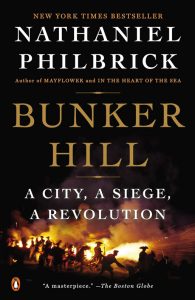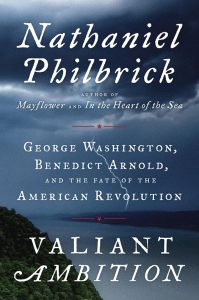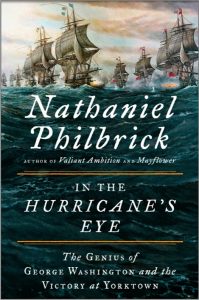If not for a series of devastating hurricanes in the Caribbean Sea in 1780, George Washington might not have met Lord Cornwallis at the Battle of Yorktown and America may never have gained her independence. This serendipitous scenario comes to the fore in Nathaniel Philbrick’s fascinating new book In the Hurricane’s Eye: The Genius of George Washington and the Victory of Yorktown. Forever the sailor, the renowned author shows how the sea was such an important factor in Washington’s strategic plans for defeating the British. If not for these crippling storms, which forced the French fleet northward, the outcome of the American Revolution could have been decidedly different.
“It was a wonderful surprise,” Philbrick said in a recent interview for Journal of the American Revolution. “I had never heard how the hurricanes in the Caribbean a year before Yorktown were so integral to what would happen in 1781.”
Philbrick has spent much of his life on and by the sea. He was a competitive sailor in school, wrote for a sailing magazine and lives on Nantucket, the “home” of Moby Dick and former capitol of the world’s whaling industry. Many of his best-selling books have something to do with the ocean: In the Heart of the Sea: The Tragedy of the Whale Ship Essex, Mayflower: A Story of Courage, Community, and War and Sea of Glory: America’s Voyage of Discovery, the U.S. Exploring Expedition, 1838-1842.
Writing in his new book, Philbrick point outs that Washington was an accomplished sailor who owned a schooner. The general spent much of his life in the Tidewater region of Virginia where transportation by water was a way of life, if not a necessity. Philbrick describes how Washington was on a barge in the Hudson River a few months before Yorktown. It grew dark and conditions worsened. Washington calmly took the tiller and carefully guided the barge to shore and safety. “There are two accounts of him taking the helm under very trying conditions,” he said. “I find that fascinating!”
So it should be no surprise that a good deal of In the Hurricane’s Eye centers on the sea and the naval engagements that made Yorktown possible. The opening chapter of his book describes how three massive hurricanes rolled through the West Indies in 1780. One is estimated to be a Category 5 storm with winds in excess of 200 miles per hour, which stripped the bark off trees in Barbados. That third tempest caught the Spanish fleet at sea and nearly destroyed it. The first almost capsized a British frigate, which avoided sinking only because it was blown ashore on Cuba.
Following these catastrophic storms, it would take the French, English and Spanish years to rebuild their fleets; they were forced to rethink their Caribbean strategies. The French opted to move North for the summer and early fall to avoid further destruction. That shift in operations was a godsend to Washington, who had begged the French for naval support for years.
“What was amazing to me was Washington’s level of understanding of the overall strategy,” Philbrick said. “A lot of people dismiss his generalship but he was really the only one who got it from the very beginning. He knew the only way it was going to work was if the French could establish naval superiority on the Atlantic seaboard, thus enabling the Americans to be victorious on land and force Britain to the negotiating table.”
The British realized the importance of the navy supporting the army. For most of the American Revolution, Great Britain controlled the coastal regions and could easily reinforce or rescue its troops by sea. Even at the Battle on Monmouth in 1778—a nominal American victory —the British army was able to escape total defeat by slipping away to New York, thanks to the efforts of the Royal Navy.
Washington pleaded with his allies to support him by sea as he tried to take on a very formidable, better-equipped and well-trained enemy. The French, however, were more concerned with protecting their interests in the Caribbean. Their sugar plantations and other possessions in the West Indies were viewed as too valuable to ignore. “Washington spent three years trying to get naval support and but the French were very lackadaisical because they were so consumed with the Caribbean,” Philbrick said. “Finally it falls together but it’s Washington pushing, pushing, pushing that makes it happen.”
When the French fleet finally moved north, Washington was almost giddy. He began a series of negotiations with General Rochambeau and admirals de Grasse and Destouches to support his overall strategic goals, which at first included taking back New York. When that became unfeasible, Washington began looking south to Virginia. “Washington understood the circumstances that would bring victory,” Philbrick said. “When those circumstances changed, he was willing to adjust and develop new plans.”
Two important naval engagements—the battles of Cape Henry and the Chesapeake—preceded the maneuvering that would lead to the Siege at Yorktown. Gen. Benedict Arnold, now a brigadier in the British army, had landed in Virginia and was wreaking havoc with the Raid on Richmond. Washington convinced Admiral Destouches to take his ships from Newport, Rhode Island, and assist with operations by the Marquis de Lafayette against Arnold. The French encountered the British fleet commanded by Admiral Arbuthnot in the Chesapeake Bay, near the mouth of the James River. After several hours of fighting, the British ships gained an advantageous position inside the bay and the French withdrew. Arbuthnot was able to reinforce Arnold and later assist with his retreat down the James River peninsula.
Though it was not the outcome Washington hoped for, the Battle of Cape Henry was the impetus needed to spur the French to further action. While Washington and Rochambeau moved their combined land forces south—first feinting toward New York to fool the British—Admiral de Grasse began moving his ships north from the West Indies into position near the Chesapeake for the conclusive clash between both fleets.
Cornwallis correctly surmised what his adversaries were plotting and began moving his army toward Yorktown, where he could easily escape across the James River with assistance from British Admiral Thomas Graves. That strategy had worked many times in the past and there was no reason to doubt that it would again.
Except before, there was no French fleet to contend with. When Graves arrived at the Chesapeake on September 5, 1781, he discovered he had opposition with the enemy in command of the bay. Both fleets maneuvered for position and the battle soon began. The British could not capitalize on a critical tactical error by the French and suffered a humiliating loss. Ships on both sides were heavy damaged but in the end the British surrendered control of the Chesapeake to the French—and ultimately victory to Washington at Yorktown.
“It’s a miracle the French won the Battle of the Chesapeake given the ragtag nature of how the fleet was assembled for the engagement,” Philbrick said. “De Grasse ordered a Line of Speed, which meant the fastest ship would lead. This left a large gap in the French line, which was a major advantage for the British. But they failed to seize the moment and lost the opportunity.”
With the British fleet subdued, it would only be a matter of time for the American and French troops. The siege began on September 26 with the encirclement of Yorktown. It would take only a few weeks to tighten the noose. After a few key skirmishes, Lord Cornwallis surrendered his army of 7,000 men. With that key defeat, the British recognized they had lost the American colonies. Negotiations began in earnest and the Treaty of Paris was signed two years later. America had her independence.
Philbrick came away from this book with a deep sense of admiration for Washington. The more he researched, the more he understood the general’s grasp of military strategy and his ability to adjust his plans according to the situation at hand. That’s why the title of his book—In the Hurricane’s Eye—is such an apt metaphor for the country’s first commander in chief. “What’s interesting about a hurricane is the tremendous forces that focus ultimately on the eye of the storm,” Philbrick said. “For me, that’s where Washington was in all of this. He was always standing amid those incredible centrifugal forces, maintaining things so that they didn’t spin out of control.”
Philbrick has now written about Washington in his last three books—his American Revolution trilogy: Bunker Hill: A City, a Siege, a Revolution, Valiant Ambition: George Washington, Benedict Arnold, and the Fate of the American Revolution and of course his most recent In the Hurricane’s Eye: The Genius of George Washington and the Victory of Yorktown. He’s not done yet. His next project will be a travelogue in which he retraces the general’s travels following the American Revolution.
“Nine months after returning to Mount Vernon in 1783, Washington headed west to investigate his properties south of Pittsburgh,” Philbrick said. “Then, when he became president, he realized he was leading thirteen little nations that didn’t see themselves as part of a coherent whole. He went on a three-leg journey visiting all the states. The road trip took him south to Savannah, Georgia, and as far north as Portsmouth, New Hampshire. So my wife and I and our dog Dora are going on a trip we are calling ‘Travels with George.’ I will be writing about Washington’s actual travels but it also will be about what America is like now and what we find on the road as we are following in his footsteps.”
















2 Comments
What a great course of events! I’ve always found truth to be more fascinating (and sometimes stranger) than fiction. I’ve read some of Mr. Philbrick’s other books and definitely will read this one. Wonderfully, it also perfectly fits in with my future doctoral dissertation.
This book is an excellent read. I find Mr. Philbrick to be a thoughtful historian, a fine and perceptive writer, and a terrific storyteller. I picked up the book thinking, “What else is there to learn about Yorktown?” and after almost three hundred engrossing pages, can now answer, “A lot!” A grand book.